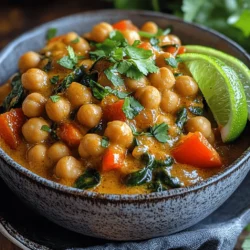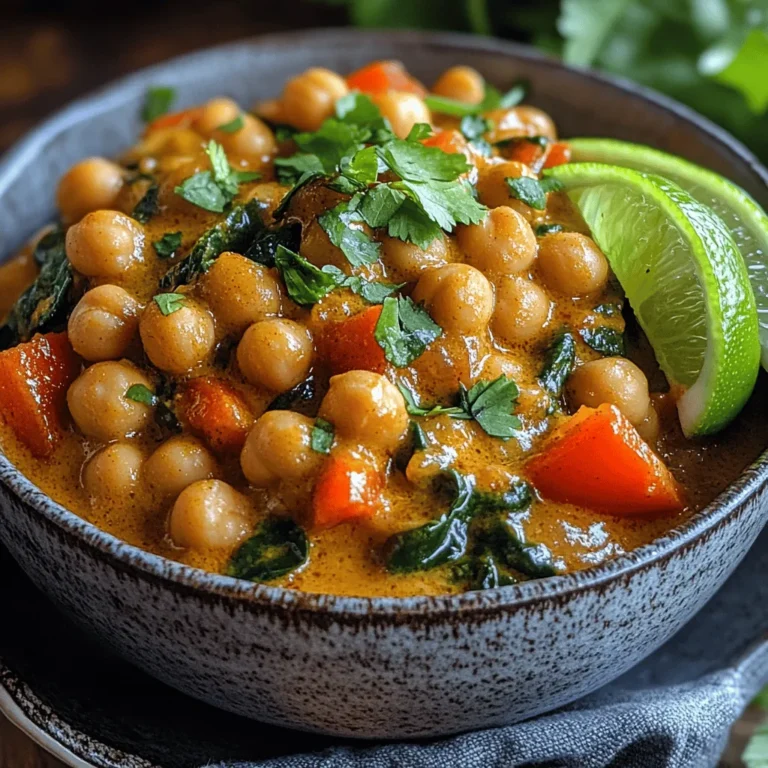Tropical Bliss: Creamy Coconut Chickpea Curry
Introduction
Tropical Bliss: Creamy Coconut Chickpea Curry is a dish that embodies the vibrant flavors of tropical cuisine while delivering a comforting and satisfying meal. This delightful curry is not only a feast for the senses but also a celebration of health-conscious eating, making it an ideal choice for any meal occasion. Whether you’re hosting a dinner party, preparing a family meal, or simply looking for a nourishing weeknight dish, this creamy curry is sure to impress.
At its core, this recipe combines the earthiness of chickpeas with the richness of coconut milk, creating a harmonious blend of taste and texture. The fusion of spices and fresh vegetables elevates the dish, making it a perfect representation of the diverse culinary traditions found in tropical regions. Additionally, the vibrant colors and enticing aromas make this dish visually appealing, inviting everyone to dig in and savor the flavors.
Beyond its taste, Tropical Bliss offers a plethora of health benefits. Chickpeas are packed with protein and fiber, making them an excellent choice for plant-based diets. Coconut milk enhances the dish with healthy fats, providing creaminess without the need for dairy. The inclusion of fresh vegetables and aromatic spices not only adds depth to the flavor profile but also contributes to the overall nutritional value of the meal.
Understanding the Ingredients
To fully appreciate the Tropical Bliss experience, it’s essential to understand the ingredients that come together to create this delectable curry. Each component plays a vital role in enhancing the dish’s flavor and nutritional content.
Chickpeas are the star of the show. These small legumes are not only versatile but also incredibly nutrient-dense. Rich in protein, fiber, and essential vitamins and minerals, chickpeas help to promote digestive health and keep you feeling full. Their nutty flavor and firm texture make them a perfect addition to stews and curries, offering both substance and satisfaction.
Coconut milk is another key ingredient that transforms the dish into a creamy delight. Made from the flesh of mature coconuts, this dairy-free alternative is rich in healthy saturated fats, specifically medium-chain triglycerides (MCTs), which are known for their potential health benefits, including improved metabolism and energy levels. The creamy texture of coconut milk adds a luxurious mouthfeel to the curry, balancing the spices and creating a comforting dish.
Aromatics like onion, garlic, and ginger are essential for building flavor in this curry. Onions provide a sweet base that caramelizes beautifully when sautéed, while garlic adds a pungent kick, and ginger introduces a warm, zesty note. These ingredients lay the groundwork for a rich, aromatic curry that will tantalize your taste buds.
Fresh vegetables, particularly red bell peppers and leafy greens, are added for both flavor and nutrition. Red bell peppers bring a natural sweetness and vibrant color to the dish, while leafy greens, such as spinach or kale, contribute essential vitamins and minerals, enhancing the overall healthfulness of the meal. The inclusion of these vegetables not only boosts the nutrient profile but also adds a satisfying crunch and freshness to the curry.
Spices are the heart and soul of any curry, and in this recipe, a blend of curry powder, cumin, turmeric, and chili powder creates a complex flavor profile. Each spice brings its own unique benefits: curry powder is rich in antioxidants, cumin aids digestion, turmeric boasts anti-inflammatory properties, and chili powder can boost metabolism. Together, these spices create a warm and aromatic base that elevates the dish to new heights.
Preparation Steps for Tropical Bliss
Now that you have a deeper understanding of the ingredients, it’s time to dive into the preparation steps that will bring this Tropical Bliss: Creamy Coconut Chickpea Curry to life. The cooking process is straightforward, making it accessible even for novice cooks.
1. Heating the Oil and Sautéing Onions: Begin by selecting a large pot or Dutch oven and heating a couple of tablespoons of oil over medium heat. A high-quality oil, such as coconut or olive oil, will complement the flavors of the curry. Once the oil is hot, add finely chopped onions. Sauté them until they turn translucent and slightly golden, which usually takes about 5-7 minutes. This step is crucial, as caramelizing the onions releases their natural sweetness, providing a flavorful base for the curry.
2. Importance of Cooking Aromatics Properly: After the onions are ready, add minced garlic and grated ginger to the pot. Sauté for an additional 1-2 minutes, stirring constantly to prevent burning. Garlic and ginger are potent aromatics that can lose their flavor if overcooked. This careful attention ensures that their vibrant flavors permeate the dish, enhancing the overall taste.
3. Techniques for Sautéing Vegetables to Maximize Flavor: Next, introduce the diced red bell pepper to the pot. Allow it to cook for about 3-4 minutes, stirring occasionally. This method not only softens the bell pepper but also allows it to absorb the flavors from the sautéed onions, garlic, and ginger. The goal is to achieve tender vegetables that still retain a bit of crunch, providing a textural contrast in the final dish.
4. Toasting Spices for Depth of Flavor: It’s time to add the spices: curry powder, cumin, turmeric, and chili powder. Before adding them to the pot, consider toasting the spices in the hot oil for about 30 seconds. This technique releases their essential oils and intensifies their flavors, resulting in a more aromatic and flavorful curry. Stir the spices with the sautéed vegetables, ensuring they are well combined.
5. Combining Chickpeas and Tomatoes to Create a Hearty Base: Now, it’s time to add the star ingredient—cooked chickpeas. If you’re using canned chickpeas, make sure to rinse and drain them before adding. Toss them into the pot along with diced tomatoes (canned or fresh) and stir everything together. The tomatoes will add acidity and brightness to the dish, balancing the richness of the coconut milk.
6. Incorporating Coconut Milk for Creaminess: Finally, pour in the creamy coconut milk and stir gently to combine all the ingredients. The coconut milk will create a luscious sauce that envelops the chickpeas and vegetables, resulting in a comforting and hearty curry. Bring the mixture to a gentle simmer, allowing the flavors to meld together for about 10-15 minutes. During this time, you can taste and adjust the seasoning with salt or additional spices to suit your palate.
With these initial steps complete, you are well on your way to creating a delectable Tropical Bliss: Creamy Coconut Chickpea Curry that is not only easy to prepare but also bursting with flavor. Stay tuned for the following sections, where we will explore the nutritional profile of this dish and provide additional tips for serving and enjoying this delightful meal.
{{image_2}}
Caloric and Nutritional Breakdown per Serving
This Tropical Bliss: Creamy Coconut Chickpea Curry is not only delicious but also packed with nutrients. Each serving (approximately 1 cup) contains about 350 calories, offering a well-rounded meal that is satisfying and nourishing. The nutritional profile includes approximately:
– Protein: 12 grams
– Carbohydrates: 40 grams
– Fat: 18 grams
– Fiber: 10 grams
– Sugars: 6 grams
Chickpeas serve as an excellent source of plant-based protein, while coconut milk contributes healthy fats that enhance flavor and texture. The combination of herbs, spices, and vegetables provides essential vitamins and minerals, making this dish not only a feast for the palate but also for your body.
Discussion on Plant-Based Proteins and Fibers from Chickpeas
Chickpeas, also known as garbanzo beans, are a powerhouse of nutrition. They are rich in plant-based protein, making them a favorite among vegans and vegetarians. Each cup of cooked chickpeas contains about 15 grams of protein, which is crucial for muscle repair and growth. Additionally, chickpeas are high in dietary fiber, with around 12 grams per cup. This fiber content aids digestion, helps maintain stable blood sugar levels, and contributes to a feeling of fullness, making it easier to manage weight.
Incorporating chickpeas into your diet can also help improve heart health. Their low glycemic index and ability to lower cholesterol levels make them a heart-friendly choice. Overall, chickpeas are a versatile ingredient that can be added to salads, soups, and, of course, curries.
Benefits of Healthy Fats from Coconut Milk
Coconut milk is another star ingredient in this curry. While it is higher in calories compared to other milk alternatives, its unique fat profile consists mainly of medium-chain triglycerides (MCTs). MCTs are known for their rapid absorption and energy-boosting properties. They can also aid in weight management by promoting a feeling of fullness.
Moreover, coconut milk adds a rich creaminess to the curry, balancing the spices and enhancing the overall flavor. It also provides essential nutrients, including vitamins C, E, and B vitamins, as well as minerals such as magnesium, potassium, and iron. These nutrients can support various bodily functions, from boosting immunity to promoting healthy skin.
Overview of Vitamins and Minerals from Added Vegetables
The vegetables included in this creamy coconut chickpea curry not only enhance flavor but also boost its nutritional value. Common additions like bell peppers, spinach, and carrots provide a variety of vitamins and minerals:
– Bell Peppers: Rich in vitamins A and C, bell peppers are powerful antioxidants that support immune function and skin health.
– Spinach: A great source of iron, calcium, and vitamins K and A, spinach also offers anti-inflammatory properties.
– Carrots: Packed with beta-carotene, which converts to vitamin A in the body, carrots promote good vision and skin health.
Adding a rainbow of vegetables not only makes the dish visually appealing but also ensures a broad spectrum of nutrients, making this curry a wholesome meal option.
Serving Suggestions and Pairings
Ideal Serving Methods: Over Rice or Quinoa
To truly enjoy the Tropical Bliss: Creamy Coconut Chickpea Curry, serve it over a bed of fluffy basmati rice or nutty quinoa. Both options complement the creamy texture of the curry beautifully. Rice absorbs the flavorful sauce, while quinoa contributes additional protein and fiber. For those seeking a low-carb option, serving the curry over cauliflower rice is an excellent alternative.
Creative Presentation Tips for an Inviting Table Setup
When it comes to presentation, first impressions matter. To create an inviting table setup:
1. Color Contrast: Use colorful bowls to serve the curry, enhancing the vibrant hues of the dish.
2. Garnishing: Top the curry with fresh cilantro or parsley for a pop of color and freshness. A sprinkle of lime juice can also add brightness.
3. Accompaniments: Serve the curry alongside warm naan or pita bread for dipping, encouraging a communal dining experience.
Suggested Sides or Accompaniments that Pair Well with the Dish
For a complete meal, consider pairing the curry with:
– Simple Cucumber Salad: A refreshing salad with diced cucumbers, tomatoes, and a drizzle of lemon juice can balance the richness of the curry.
– Raita: This yogurt-based condiment, flavored with mint and cumin, can help cool the palate if the curry has a kick.
– Pickled Vegetables: A side of pickled onions or other vegetables can add a tangy contrast that enhances the overall flavor profile.
Culinary Variations to Explore
Suggestions for Ingredient Substitutions or Additions
While the original recipe is divine, feel free to experiment with variations that suit your taste preferences:
– Different Greens: While spinach is a classic addition, kale can provide a heartier texture and additional nutrients. Just ensure to cook it down a bit longer to achieve tenderness.
– Alternative Protein Sources: If you want to switch things up, try adding tofu or tempeh for a different protein source. Both options can absorb the flavors of the curry beautifully.
– Spice Level Adjustments: Depending on your heat tolerance, you can adjust the spice level. Adding more chili peppers or a pinch of cayenne can elevate the heat, while omitting them altogether will create a milder dish.
Spice Level Adjustments and Their Impact on Flavor
Adjusting the spices can significantly change the flavor profile of your curry. For a sweeter taste, consider adding a pinch of sugar or a splash of maple syrup. Conversely, if you prefer a more savory dish, a touch of soy sauce or tamari can enhance umami flavors. Always taste as you go to ensure the balance is to your liking.
Cultural Context of Chickpea Curry
Historical Background of Chickpea Dishes in Various Cuisines
Chickpeas have a rich culinary history, dating back thousands of years to the Mediterranean and Middle Eastern regions. They are a staple in various cuisines, from Middle Eastern hummus to Indian chana masala. In the context of curries, chickpeas are often celebrated for their versatility and ability to absorb flavors from spices and other ingredients.
Popularity of Curries in Tropical Regions and Their Significance
Curries are particularly popular in tropical regions, where the abundance of spices and fresh produce creates a vibrant culinary landscape. Countries like India, Thailand, and the Caribbean have their unique interpretations of curry, often reflecting local ingredients and cultural influences. In many of these cultures, curry is more than just food; it’s a communal experience that brings people together around the table.
Conclusion
In summary, the Tropical Bliss: Creamy Coconut Chickpea Curry is not only a delicious and satisfying meal but also a powerhouse of nutrition. With the benefits of protein-rich chickpeas, heart-healthy coconut milk, and a variety of nutrient-dense vegetables, this dish caters to various dietary preferences and occasions. Whether you choose to serve it over rice, quinoa, or cauliflower rice, the possibilities for customization are endless.
We encourage you to experiment with this recipe, making it your own by incorporating different vegetables, spices, or protein sources. The versatility of this curry ensures that it will become a staple in your kitchen, whether for a weeknight dinner or a special gathering. Embrace the flavors, enjoy the process, and savor the Tropical Bliss of this creamy chickpea curry!


